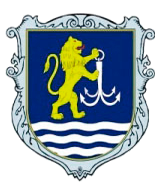DYNAMIC SIMILARITY OF ELECTRIC SHIPS’ PROPULSIVE COMPLEXES
Abstract
The purpose of the research is to develop methods for analyzing the maneuvering modes of ship propulsion systems based on the theory of dynamic similarity. Methodology. On maneuvers, all components of the complexes operate in transient modes, significantly influencing each other, therefore, the analysis of the operation modes of any component is considered in unity with the others. The necessity of transition to generalized mathematical models is substantiated. The dynamic similarity criteria are found. There is a possibility of broad generalization of research results. Results. A mathematical model and a method for calculating the transient modes of electric ships’ propulsion complexes have been developed. The generalized dimensionless parameters of the complex are found. The expediency of conducting research in relation to these parameters and dynamic similarity criteria are substantiated. A technique for conducting research using the provisions of dynamic similarity theory has been developed. The possibilities of using the technique are illustrated by the example of calculating the maneuvering characteristics and assessing the loads on the electric power plant when the electric ship enters circulation. The possibility of using the developed technique in the search for ways to improve complexes’ maneuverability is shown. Scientific novelty. The use of dynamic similarity criteria and generalized dimensionless parameters makes it possible to cover a large class of ships in research. Electric ships with equal values of similarity criteria and equal values of generalized parameters will have the same laws of change of regime indicators and equal values of maneuvering quality indicators. It becomes possible to level the influence of inaccuracies in the assessment of external factors on the results of research. Practical significance. The recommendations, analytical ratios, diagrams for assessing the quality of maneuvering, developed on the basis of the theory of similarity, cover a whole series of electric ships and are ready for use. They contribute to the construction of electric ships with predictable maneuvering properties. Bible 15, Tab. 2, Fig. 1.
Downloads
References
2. Radan D. Integrated Control of Marine Electrical Power System: Thesis for the Degree of Philosophy Doctor / D. Radan. Norwegian University of Science and Technology, 2008. 231 p.
3. Yukun Feng, Zuogang Chen, Yi Dai, Ping Wang. An experimental and numerical investigation on hydrodynamic characteristics of the bow thruster. Ocean Engineering, 2020, vol. 209(8):107348. doi: 10.1016/j.oceaneng.2020.107348.
4. Teresa Abramowicz-Gerigk, Miroslaw K. Gerigk. Experimental study on the selected aspects of bow thruster generated flow field at ship zero-speed conditions. Ocean Engineering, 2020, vol. 209(92):107463. doi: 10.1016/j.oceaneng.2020.107463.
5. Liu Hui, Feng Yukun, Chen Zuogang, Dai Yi, Tian Ximin. Numerical Study of Pressure Fluctuation for Bow Thruster. Journal of Shanghai Jiaotong University, 2017, vol. 51(3), pp. 294-299. doi: 10.16183/j.cnki.jsjtu.2017.03.007.
6. Ionut Cristian Scurtu, Valentin Oncica. Combined CFX and Structural Simulation for Bow Thrusters Loading under Operating Conditions. Journal of Physics Conference Series, 2018, vol. 1122(1):012024. doi: 10.1088/1742-6596/1122/1/012024.
7. Sardono Sarwito, Semin Semin, Muhammad Badrus Zaman, Kamarul Hawari Ghazali. Unbalanced Voltages of Bow Thruster Motor Performance in the Ship Using Simulation. International Review of Electrical Engineering (IREE) , 2021, vol. 16(5):455. doi: 10.15866/iree.v16i5.18132.
8. O. Kupraty. Mathematical modelling of construction of ship turning trajectory using autonomous bow thruster work and research of bow thruster control specifics. Scientific Journal of Gdynia Maritime University, No. 118, June 2021, pp. 7-23. doi: 10.26408/118.01.
9. Andrzej Kopczyński. Hybrid expert system for computer-aided design of ship thruster subsystems. IEEE Access, Volume 8, 2020. doi:10.1109/ACCESS.2020.2982264.
10. Ruth, E. Propulsion Control and Thrust Allocation on Marine Vessels. Ph.D. Thesis, NTNU Norwegian University of Science and Technology, Trondheim, Norway, 2008. 222 р.
11. Jarosław Artyszuk and Paweł Zalewski. Energy Savings by Optimization of Thrusters Allocation during Complex Ship Manoeuvres. Energies 2021, 14(16), 4959; doi:10.3390/en14164959.
12. Яровенко В. А. Расчет и оптимизация переходных режимов пропульсивных комплексов электроходов. Одесса: «Маяк», 1999. 188 с.
13. Небеснов В. И. Вопросы совместной работы двигателей, винтов, и корпуса судна. Судостроение, 1965. 247 с.
14. Яровенко В.А., Черников П.C. Метод расчета переходных режимов гребных электроэнергетических установок электроходов. Електротехніка і електромеханіка, 2017, № 6, С. 32-41. doi: 10.20998/2074-272X.2017.6.05.
15. Яровенко В.А., Зарицкая Е.И. Cпособ оценки нагрузок на гребные электрические установки электроходов при циркуляционном движении Вісник Одеського державного морського університету. – Одеса: ОНМУ. 2014. № 1(40). С. 89-103.





